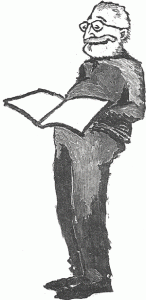Recent Books
*Harste, J. C. (2021). Researching Literate Lives: The Selected Work of Jerome C. Harste (World Library of Educationist Series). New York: Routledge.
*Vasquez, V., Harste, J. C., & Albers, P. (2020). Using Art Critically (Volume 1). Washington: Creating Critical Curriculum Press.
*Harste, J. C., Albers, P, & Vasquez, V. (2020). Using Art Critically (Volume 2). Washington: Creating Critical Curriculum Press.
*Albers, P., Vasquez, V., & Harste, J. C. (2020). Using Art Critically (Volume 3) . Washington: Creating Critical Curriculum Press.
*Leland, C., Lewison, M., & Harste, J. C. (2021). Teaching K-8 Reading: Disrupting 10 Literacy Myths. NY: Routledge.
*Leland, C., Lewison, M., & Harste, J.. C. (20 19). Teaching Children’s Literature: It’s Critical (2nd Edition). Routledge.
*Lewison, M., Leland, C., & Harste, J. C. (2015). Creating Critical Classrooms: Reading and Writing with an Edge (2nd Edition). NY: Routledge
Most of the following files are in .pdf format. You need Acrobat Reader to access them. If you do not have the program, you can download the Adobe PDF Reader.
- Taking a Critical Stance: Its Not Just the Books You Choose (Adventuring with Books, 2002)
- Jerry Harste: Still Challenging the Curriculum, Decades into His Career (Cllopy, T. [2013]. The Council Chronicle, November, pp 23-26).Chronicle Article
- Researching Literate Lives (Linking families, literacy and learning: Perspectives from Parent Researchers, 2014)
- Talking Trade: Literacy Researchers as Practicing Artists (LRA Yearbook, 2012)
- Speaking Within the Lines: An Autoethnographical Study of Three Literacy Researcher-Artists (Journal of Adult and Adolescent Literacy, 2012).
- Annotate Final 2 6 12: Annotated List of Children’s Books Which Raise Important Social Issues Worth Discussion in Classrooms (Creating Critical Classrooms, 2012).
- Understanding Reading, Multiple Perspectives, Multiple Insights (LRA, 2013)
- Reading–Writing Connection (Encyclopedia of Applied Linguistics, 2012)
- Transmediation: What Art Affords (LRA, 2014) Figures (LRA, 2014, to go with paper entitled “Transmediation: What Art Affords Our Understanding of Literacy (Oscar Causey Address at LRA 2013 Convention).
- I’m risking it! (Journal of Adult and Adolescent Literacy, 2012)
- Curriculum as Identity: Writing the Word, Writing the World (Talking Points, Campano, Leland, Harste, 2004)
- Doing What We Want to Become: Preparing New Urban Teachers (Urban Education, 2005)
- Semiotics: Encyclopedia Entry (Literacy in America, Berghoff & Harste, 2002)
- Little Red Riding Hood (NRC Yearbook, Harste, Leland, Jackson, 2002)
- A Critical Commentary: Indiana Study Group (Australian Secondary Reading Study).
- Supporting Critical Conversation Original(Adventuring With Books, 1999)
- New Times: First-Person Shooter Games Go to College (LRA, 2004)
- NCTE Presidential Address (1999)
More articles published at the NCTE CoLEARN’s database.
The following resources are in .PDF format:
What Do We Mean by Literacy Now?
Jerry has written the lead article in the March 2003 issue of Voices from the Middle. Entitled “What do we mean by literacy now?” the article uses Halliday and others to discuss a language arts program focused on meaning-making, language study, and inquiry-based learning.
Source: http://www.ncte.org/pdfs/subscribers-only/vm/0103-march03/VM0103What.pdf
The Work We Do: Journal as Audit Trail (1231)
Offers a peek inside the journals kept by a well-known language-arts educator, which he uses as a repository for his thoughts, drawings, articles of interest, notes from conversations with others on his own work, the work of others, and education in general. Shows how the journal is an “audit trail” of its owner’s learning.
Author(s): Jerome C. Harste and Vivian Vasquez
Source: Language Arts, Vol. 75 No. 4, April 1998
Exploring Critical Literacy: You Can Hear a Pin Drop (534)
This article focuses on texts that have the power to engage students in “critical” conversations about issues of power and social justice.
Author(s): Jerome C. Harste, Christine Leland, Anne Ociepha, Mitzi Lewison and Vivian Vasquez
Source: Language Arts, Vol. 77 No. 1, September 1999
What Education as Inquiry Is and Isn’t (471)
Chapter 1
Author(s): Jerome C. Harste
Source: Excerpted from Critiquing Whole Language and Classroom Inquiry (NCTE, 2001)
Critical Literacy: Enlarging the Space of the Possible (465)
The authors offer several ways to think about the teacher’s role in the teaching of reading, noting that a curriculum built on critical literacy is one that highlights diversity and difference while calling attention to how people are constructed as literate beings. They argue that students should position themselves as social activists who challenge the status quo and ask for change.
Author(s): Christine H. Leland and Jerome C. Harste
Source: Primary Voices K-6, Vol. 9 No. 2, October 2000
“I Just Wanted to Raise a Nice Boy!”: Being Critical and Political (371)
Shows how progressive educational practices have come to challenge cultural norms, and will trace the evolution of his own philosophy and practice.
Author(s): Jerome C. Harste and Andrew Manning
Source: Talking Points, vol. 13.1 (October/November 2001)
What Do We Mean When We Say We Want Our Children to Be Literate? (203)
Language educators Kathy Egawa and Jerry Harste offer a new and fuller picture of “balance” to the ones frequently operating in elementary classrooms.
Author(s): Marianne Marino, Jane Hansen, Kathy Egawa and Jerome C. Harste
Source: School Talk, Vol. 7, No. 1, October 2001
Teaching, Learning, and Growing as a Member of a Professional Education Community (141)
What role do professional organizations play in helping us live our lives as intellectuals? David Bloome and Jerome C. Harste talk of the importance to them of NCTE’s professional community.
Author(s): David Bloome and Jerome C. Harste
Source: Language Arts, Vol. 79 No. 1, September 2001
